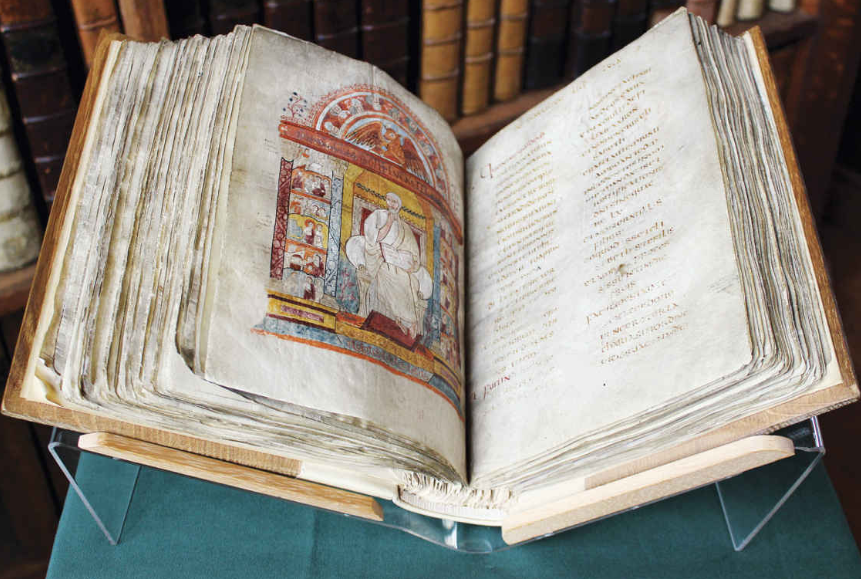Thursday, July 31, 2025
"Quant de lais..." -- Part 2
Wednesday, July 9, 2025
"Quant de lais...
...faire m'entremet, ne voil ublier Bisclavret" -- the first two lines of the lai. Marie tells us that while she is making lais, she must not forget the one about Bisclavret, the werewolf; and, not coincidentally, reminds us that we should not forget her, the poet.
🌀
One of my early efforts was collecting capital letters:
Friday, July 4, 2025
Title page, then and now
As an example of the way my thinking about this project has evolved, this is the first title page from the end of December, last year:
Saturday, June 28, 2025
Choices, Part 2
The Materials: Ink and Paper.
First of all, let me be clear: I love paint. I want all the colors. I can spend days making color charts. Eight tubes of earth red oil colors are not overkill; believe me, Venetian red is not Pompeian red is not Terra Rosa is not Pozzuoli earth, and that's just Williamsburg.
And now there is INK.
(A disclaimer, of sorts: trials and practice have gone on now for more than a year. This post is a description of where I started. Some learning and plain old mind-changing have happened over time, which I'll eventually get to. Probably.)
Wednesday, June 18, 2025
Influences (Books)
Discovered (separately, years apart) while wandering around the library:
The Paper Garden: An Artist (Begins Her Life's Work) at 72, by Molly Peacock
One of Mary Delany's cut-paper "mosaicks"
Meetings with Remarkable Manuscripts: Twelve Journeys into the Medieval World, by Christopher de Hamel
The Codex Amiatinus
Thursday, May 29, 2025
Choices, Part 1
The beginning of any artwork, any project, involves a number of choices. Sometimes it's easy: a drawing in a sketchbook needs no more than the book and a pencil (and maybe an eraser). There the hardest choice is "which pencil?"
This illuminated manuscript I've undertaken has required quite a few more, almost all of them provisional.
The Text. I chose The Lais of Marie de France, Text and Translation, edited and translated by Claire M. Waters (Broadview Press, 2018), because it includes all the lais, uses only Harley 978 for the text, and has the Old French text and the modern English translation on facing pages.
The Script. Although I had been practicing textura quadrata, I decided in the interest of both authenticity and legibility to study and imitate the unnamed scribe of Harley 978. I enlarged a piece of folio 118va until the thick parts of its letters matched the width of my pen (an Osmiroid calligraphy fountain pen from the early 1970s with a B-4 nib) and started tracing. Chris made me a slanted writing table with a plexiglass top I could illuminate from below that made both the lettering more comfortable and the tracing clearer. Also, Canson XL Marker is a smooth, translucent paper that's a joy to write on.
Saturday, May 17, 2025
Genesis
I belong to a book club.
This isn't unusual in this small town: it seems like everyone I meet belongs to a book club, but it's never the same one. "My" book club is Women Read, sponsored by the local library. By September, each member has chosen a book for the club to read in the coming (school) year and agreed to lead the discussion. My choice for April of 2024 was Matrix, by Lauren Groff, a novel about the 12th-century writer known as Marie de France, which I had read earlier that year.
The novel so impressed and intrigued me that I began to research (i.e., gather information on the Web about) Marie and her writings, and came across a manuscript in the British Library (Harley 978**) that contained the twelve lais* attributed to her, written in Old French (or Anglo-Norman French, as she lived in England). I downloaded a couple of pages; this is the Prologue.
The Marie Project
Resurrection
Eleven years later, this blog still exists. I guess I'll try using it again, after some editing. There were lots of broken links and outdated announcements, and I'm still pondering whether to delete some WIP posts that in retrospect just seem repetitive. Also, it seems like there was an inverse relationship between the success of the painting and how many photos I took and posted.
It's been some time since I retired from the business of art making, the galleries, openings, submissions to shows, carting the paintings around, trying to do marketing with the website and this blog. I really don't miss most of it. However, I have been recently reminded how much I do like to talk (and write) about what I do. It gives me some clarity, a little distance, a bit of perspective; and I like the opportunity to share what I've learned about materials and techniques.
My intention here is to document my current long-term project (it will take a while to catch up), and also to use this space to archive some work, now that the website is defunct.
So here goes.























